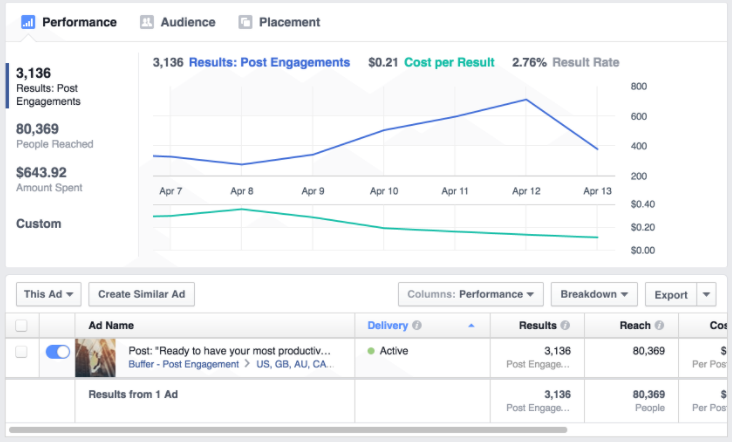
Marketing • Business

Sensis recently reported that the number of Australian businesses investing in social media is on the rise. The average Australian business spends between $1000 and $5000 per year on social media advertising, with paid ads now used by

How does your social media investment compare? If you’re not entirely sure, you’re in good company, because Sensis also found that most business owners don’t know how much they’re spending, how much they should be spending, and where they should spend it.
And with good reason, too. As you might expect, there’s no one-size-fits-all approach to social media spending. But there are ways to make your social media dollars stretch further, and give you higher returns—which is the goal of any investment, really. And that’s the topic of this week’s deep-dive into social media.
Before we get started, it’s important to understand that social media trends are rapidly changing, and what works well for your business in 2018 might be ineffective in 2019. But if you’re consistently calculating your return on investment (ROI) in social media, you should be able to respond to what your fans and followers want.
Keep in mind that your social marketing campaigns don’t happen in isolation from the rest of your business development activities. So it can be hard to determine how much of your profit increase should be attributed to your social media marketing campaigns instead of your other marketing campaigns, organic search, or personal referrals. Environmental factors can even play a part—are more people viewing your air conditioner product pages because of your social media efforts, or because this summer is set to be a scorcher?
While it can be tempting to compare your social performance to others’, it’s not a particularly good measure of whether your work is paying off. This is because everyone will calculate their investment slightly differently, and there’s no way for you to know whether they were only including paid advertising or also their software and image licensing fees, employee wages, and self-education expenses. You’ll learn a lot more if you focus on your own results and learn what’s working reliably for your business.
The first step is to understand what you’re trying to accomplish through your social media campaigns. This will help you come up with a meaningful and measurable performance indicator for that goal.
For example, if you’re looking to increase profits this quarter, you might measure:
But if you’re interested in growing your fan base this quarter so you can boost sales over the next twelve months, you might instead look at metrics that focus solely on social growth, rather than conversions e.g.
Once you’ve decided which metrics you’ll use, you can extract the relevant data from your social media platform insights and your financial platform. This will let you track your performance over time to see what’s working for your business.

It’s essential to approach your social media analysis with a sense of curiosity. It can take some time to determine what’s working best. You might see one social media platform outperforming the others, but when you increase your spend on that platform, you don’t see conversions get any higher. Or you might find that an underperforming platform responds well when you increase your spend. So don’t get too fixated on short-term results.
However, if one of your platforms is consistently underperforming, and you’ve tried several different tactics to no avail, consider whether you really need to invest in that platform. Maybe your target audience is hanging out elsewhere. It’s understandable that you want your business to have a presence on all the major social platforms, but you don’t need to give them all the same level of attention. Instead, focus your efforts—and your financial investment—on the platforms that work.
So, what does it mean to invest in social media? That’s up to you, but it could mean:
Start with the options that appeal to you, and if they don’t work, try something different. You’re really only limited by your budget and your imagination. (We can’t really help with the latter, but we have a few ideas for stretching that budget further.)

| Related Reading: 3 Things Customers Want on Social Media (and How to Convert Them)
The best way to get more value for your social media money is to extend the reach and the lifespan of your content. There are a few ways to do this.
When you repost others’ content, you basically get free hits—you’re sharing something that’s proven to be popular with a well-matched audience, and is therefore likely to be popular with your audience. You can reshare from your competitors, suppliers, and customers, and small players will often appreciate the shout-out and may even feel compelled to pay it back later. A word of caution, though: make sure the content is attributed fairly to its source, and that you’re not breaching copyright by sharing further.
You can also repeat your own posts, either manually or with a social media tool like Buffer or SocialOomph. This can help you reach new audiences with posts that have performed well in the past, extending your effective reach. Make sure you post plenty of new content as well, so your fans don’t get bored.

If you’ve developed content for a particular platform, you may be able to repurpose it for another platform. You may find that this means resizing an image or changing the text, but that’s a small investment with a high possible return of reaching a whole new audience.
| Related Reading: The 14 Best Tools to Save Time and Grow Your Business (+2 Bonus Tools)
There are no hard and fast rules to social media marketing. Everyone has their favourite strategies and favourite platforms, and the key to maximising your returns is to keep testing and adjusting your approach until you find the right mix for your business…for now. And then repeat, because it’s going to change over time, and if you keep monitoring your ROI, you’ll be able to adapt to the trends.
Neto is the only Australian retail management platform that provides a complete solution for ecommerce, point of sale, inventory, and fulfilment. Our integrated back-end technology enables exceptional and consistent customer experiences via any channel, be it in-store, online or through a marketplace. We automate repetitive tasks and integrate with multiple sales channels to manage orders and shipments. And our inbuilt analytics and social media sharing will help you optimise your social media strategy for successful campaigns and social conversions.
